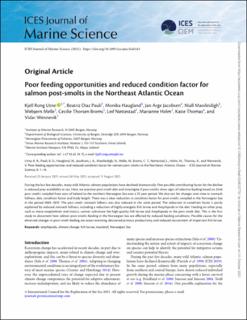Poor feeding opportunities and reduced condition factor for salmon post-smolts in the Northeast Atlantic Ocean
| dc.contributor.author | Utne, Kjell Rong | |
| dc.contributor.author | Pauli, Beatriz Diaz | |
| dc.contributor.author | Haugland, Monika | |
| dc.contributor.author | Jacobsen, Jan Arge | |
| dc.contributor.author | Maoileidigh, Niall O´ | |
| dc.contributor.author | Melle, Webjørn Raunsgård | |
| dc.contributor.author | Broms, Cecilie | |
| dc.contributor.author | Nøttestad, Leif | |
| dc.contributor.author | Holm, Marianne | |
| dc.contributor.author | Thomas, Katie | |
| dc.contributor.author | Wennevik, Vidar | |
| dc.date.accessioned | 2021-10-04T12:40:31Z | |
| dc.date.available | 2021-10-04T12:40:31Z | |
| dc.date.created | 2021-09-13T11:12:07Z | |
| dc.date.issued | 2021 | |
| dc.identifier.citation | ICES Journal of Marine Science. 2021, 1-14. | |
| dc.identifier.issn | 1054-3139 | |
| dc.identifier.uri | https://hdl.handle.net/11250/2787508 | |
| dc.description.abstract | During the last few decades, many wild Atlantic salmon populations have declined dramatically. One possible contributing factor for the decline is reduced prey availability at sea. Here, we examine post-smolt diet and investigate if post-smolts show signs of selective feeding based on 2546 post-smolts sampled from west of Ireland to the northern Norwegian Sea over a 25-year period. We also test for changes over time in stomach fullness, diet, condition factor and body length. There was a clear reduction in condition factor for post-smolts sampled in the Norwegian Sea in the period 2003–2012. The post-smolt stomach fullness was also reduced in the same period. The reduction in condition factor is partly explained by reduced stomach fullness, including a reduction of highly energetic fish larvae and Amphipoda in the diet. Feeding on other prey, such as meso-zooplankton and insects, cannot substitute the high-quality fish larvae and Amphipoda in the post-smolt diet. This is the first study to document how salmon post-smolts feeding in the Norwegian Sea are affected by reduced feeding conditions. Possible causes for the observed changes in post-smolt feeding are ocean warming, decreased primary productivity, and reduced recruitment of important fish larvae. | |
| dc.language.iso | eng | |
| dc.title | Poor feeding opportunities and reduced condition factor for salmon post-smolts in the Northeast Atlantic Ocean | |
| dc.type | Peer reviewed | |
| dc.type | Journal article | |
| dc.description.version | publishedVersion | |
| dc.source.pagenumber | 1-14 | |
| dc.source.journal | ICES Journal of Marine Science | |
| dc.identifier.doi | 10.1093/icesjms/fsab163 | |
| dc.identifier.cristin | 1933680 | |
| dc.relation.project | Norges forskningsråd: 280308 | |
| cristin.ispublished | true | |
| cristin.fulltext | original | |
| cristin.qualitycode | 1 |
Tilhørende fil(er)
Denne innførselen finnes i følgende samling(er)
-
Articles [3012]
-
Publikasjoner fra CRIStin [3066]
